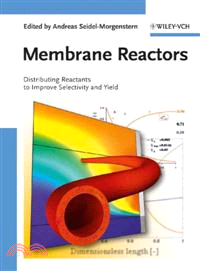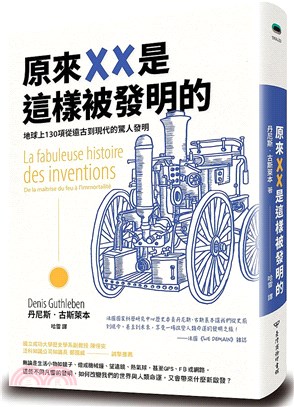Membrane Reactors - Distributing Reactants To Improve Selecitivity And Yield
商品資訊
ISBN13:9783527320394
出版社:John Wiley & Sons Inc
作者:Seidel-Morgenst
出版日:2010/04/19
裝訂/頁數:精裝/292頁
定價
:NT$ 6460 元優惠價
:90 折 5814 元
若需訂購本書,請電洽客服 02-25006600[分機130、131]。
商品簡介
作者簡介
目次
相關商品
商品簡介
This authoritative work represents a broad treatment of the field, including the basic principles of membrane reactors, a comparative study of these and conventional fixed-bed reactors or multi-tube reactors, modeling, industrial applications, and emerging applications -- all based on case studies and model reactions with a stringent mathematical framework.
The significant progress made over the last few years in this inherently hot multidisciplinary field is summarized in a competent manner, such that the novice can grasp the elementary concepts, while professionals can familiarize themselves with the latest developments in the area. For the industrial practitioner, this practical book covers all important current and potential future applications.
The significant progress made over the last few years in this inherently hot multidisciplinary field is summarized in a competent manner, such that the novice can grasp the elementary concepts, while professionals can familiarize themselves with the latest developments in the area. For the industrial practitioner, this practical book covers all important current and potential future applications.
作者簡介
Andreas Seidel-Morgenstern received his PhD in 1987 from the Institute of Physical Chemistry of the Academy of Sciences in Berlin. Between 1991 and 1992 he worked as a postdoctoral fellow at the University of Tennessee in Knoxville. In 1994 he finished the Habilitation at the Technical University in Berlin. He has industrial experience with Schering AG (1995) and has consulted for various companies in the areas of separation science and reaction engineering. Since 1995 he has been Professor of Chemical Process Engineering at the Otto von Guericke University in Magdeburg. He was appointed to the position of Director at the Max Planck Institute for Dynamics of Complex Technical Systems in Magdeburg in 2002 where he leads the department “Physical and Chemical Foundations of Process Engineering.” Among his numerous awards, he received the Max Buchner Award of Dechema in 2000, the Otto von Guericke Research Award of the Magdeburg University in 2002 and in 2008 he received an Honoris Causa Doctorate from the Lappeenranta University in Finland. His current research interests include reaction engineering, heterogeneous catalysis, preparative chromatography and enantioselective crystallization.
目次
Preface.
List of Contributors.
1 Basic Problems of Chemical Reaction Engineering and Potential of Membrane Reactors (Sascha Thomas, Christof Hamel, and Andreas Seidel-Morgenstern).
1.1 Challenges in Chemical Reaction Engineering.
1.2 Concepts of Membrane Reactors.
1.3 Available Membranes.
1.4 Illustration of the Selectivity Problem.
1.5 Reaction Rate, Conversion, Selectivity and Yield.
1.5.1 Reaction Rates.
1.5.2 Conversion.
1.5.3 Mass Balance of a Plug Flow Tubular Reactor.
1.5.4 Selectivity and Yield.
1.6 Distributed Dosing in Packed-Bed and Membrane Reactors.
1.6.1 Adjusting Local Concentrations to Enhance Selectivities.
1.6.2 Optimization of Dosing Profiles.
1.7 Kinetic Compatibility in Membrane Reactors.
1.8 Current Status of Membrane Reactors of the Distributor Type.
Notation Used in this Chapter.
Greek Symbols.
Superscripts and Subscripts.
Abbreviations.
References.
2 Modeling of Membrane Reactors (Michael Mangold, Jürgen Schmidt, Lutz Tobiska, and Evangelos Tsotsas).
2.1 Introduction.
2.2 Momentum, Mass and Heat Balances.
2.3 Transport Kinetics.
2.3.1 Fluid-Filled Regions.
2.3.1.1 Molecular Transport of Momentum.
2.3.1.2 Heat Conduction.
2.3.1.3 Molecular Diffusion.
2.3.2 Porous Domains.
2.3.2.1 Molecular Diffusion.
2.3.2.2 Knudsen Diffusion.
2.3.2.3 Viscous Flow.
2.3.2.4 Models for Description of Gas Phase Transport in Porous Media.
2.4 Reduced Models.
2.5 Solvability, Discretization Methods and Fast Solution.
2.6 Implementation in FLUENT, MooNMD, COMSOL and ProMoT.
2.6.1 Application of FLUENT.
2.6.2 Application of MooNMD.
2.6.3 Application of ProMoT.
2.7 Conclusion.
Notation Used in this Chapter.
Latin Notation.
Greek Notation.
Super- and Subscripts.
References.
3 Catalysis and Reaction Kinetics of a Model Reaction (Frank Klose, Milind Joshi, Tanya Wolff, Henning Haida, Andreas Seidel-Morgenstern, Yuri Suchorski and H. Weiß).
3.1 Introduction.
3.2 The Reaction Network of the Oxidative Dehydrogenation of Ethane.
3.3 Catalysts and Structure-Activity Relations.
3.3.1 Catalyst Preparation and Characterization.
3.3.2 Mechanistic Aspects: Correlation Betweeen Structure and Activity.
3.4 Derivation of a Kinetic Model.
3.4.1 Experimental.
3.4.1.1 Catalyst.
3.4.1.2 Set-Up.
3.4.1.3 Procedures.
3.4.2 Qualitative Trends.
3.4.2.1 Overall Catalyst Performance.
3.4.2.2 Evaluation of Intraparticle Mass Transfer Limitations.
3.4.3 Quantitative Evaluation.
3.4.3.1 Simplified Reactor Model and Data Analysis.
3.4.3.2 Kinetic Models.
3.4.3.3 Parameter Estimation.
3.4.4 Suggested Simplified Model.
Special Notation not Mentioned in Chapter 2.
Latin Notation.
Greek Notation.
References.
4 Transport Phenomena in Porous Membranes and Membrane Reactors (Katya Georgieva-Angelova, Velislava Edreva, Arshad Hussain, Piotr Skrzypacz, Lutz Tobiska, Andreas Seidel-Morgenstern, Evangelos Tsotsas, and Jürgen Schimdt).
4.1 Introduction.
4.2 Aspects of Discretizing Convection-Diffusion Equations.
4.3 Velocity Fields in Membrane Reactors.
4.4 Determination of Transport Coefficients and Validation of Models.
4.4.1 Mass Transport Parameters of Multilayer Ceramic Membranes – Pre-cursors Available.
4.4.1.1 Task and Tools.
4.4.1.2 Identification by Single Gas Permeation.
4.4.1.3 Validation by Isobarid Diffusion and by Transient Diffusion.
4.4.2 Mass Transport Parameters of Metallic Membranes – Precursors not Available.
4.4.2.1 Diagnosis.
4.4.2.2 Identification.
4.4.2.3 Validation.
4.4.3 Mass Transport in 2-D Models.
4.5 Analysis of Convective and Diffusive Transport Phenomena in a CMR.
4.6 Parametric Study of a CMR.
4.6.1 Influence of Characteristic Geometrical Parameters.
4.6.2 Influence of the Morphological Membrane Parameters in the Catalyst Layer.
4.6.3 Influence of the Operating Conditions.
4.7 Conclusion.
References.
5 Packed-Bed Membrane Reactors (Christof Hamel, Ámel Tóta, Frank Klose, Evangelos Tsotsas, And Andreas Seidel-Morgenstern).
5.1 Introduction.
5.2 Principles and Modeling.
5.2.1 Reactant Dosing in a Packed-Bed Membrane Reactor Cascade.
5.2.2 Modeling Single-Stage and Multi-Stage Membrane Reactors.
5.2.2.1 Simplified 1-D Model.
5.2.2.2 More Detailed 1+1-D Model.
5.2.2.3 Detailed 2-D Modeling of a Single-Stage PBMR.
5.3 Model-Based Analysis of a Distributed Dosing via Membranes.
5.3.1 Model Reactions.
5.3.2 Simulation Study for ODH of Ethane Using the 1-D Model.
5.4 Experimental.
5.4.1 Catalyst and Used Membrane Materials.
5.4.2 Single-Stage Packed-Bed Membrane Reactor in a Pilot-Scale.
5.4.3 Reference Concept – Conventional Fixed-Bed Reactor.
5.4.4 Multi-Stage Membrane Reactor Cascade.
5.4.5 Analytics.
5.4.6 Experimental Conditions.
5.5 Results for the Oxidative Dehydrogenation of Ethane to Ethylene.
5.5.1 Comparison Between PBR and PBMR Using Ceramic Membranes in a Single-Stage Operation Mode.
5.5.2 2-D Simulation Results – Comparison Between PBR and PBMR.
5.5.3 Application of Sintered Metal Membranes for the ODH of Ethane.
5.5.4 Investigation of a Membrane Reactor Cascade – Impact of Dosing Profiles.
5.5.5 Quantitative Comparison of the Investigated Reactor Configurations.
5.6 Results for the Oxidative Dehydrogenation of Propane.
5.6.1 Comparisons Between PBR and a Single-Stage PBMR Using Ceramic Membranes.
5.6.2 Investigation of a Three-Stage Membrane Reactor Cascade.
5.7 Summary and Conclusions.
Special Notation not Mentioned in Chapter 2.
Latin Notation.
Greek Notation.
References.
6 Fluidized-Bed Membrane Reactors (Desislava Tóta, Ákos Tóta, Stefan Heinrich , and Lothar Mörl).
6.1 Introduction.
6.2 Modeling of the Distributed Reactant Dosage in Fluidized Beds.
6.2.1 Theory.
6.2.2 Parametric Sensitivity of the Model.
6.2.2.1 Bubble Size.
6.2.2.2 Secondary Gas Distribution.
6.2.3 Comparison Between Co-Feed and Distributed Oxygen Dosage.
6.3 Experimental.
6.3.1 Experimental Set-Up.
6.3.2 Experimental Procedure.
6.3.3 Results and Discussions.
6.3.4 Influence of the Oxygen Concentration.
6.3.5 Influence of the Temperature.
6.3.6 Influence of the Superficial Gas Velocity.
6.3.7 Influence of the Secondary to Primary Gas Flow Ratio.
6.3.8 Influence of Distributed Reactant Dosing with Oxygen in the Primary Gas Flow.
6.4 Conclusions.
Special Notation not Mentioned in Chapter 2.
Latin Notation.
Greek Notation.
Subscripts and Superscripts.
References.
7 Solid Electrolyte Membrane Reactors (Liisa Rihko-Struckmann, Barbara Munder, Ljubomir Chalakov, and Kai Sundmacher).
7.1 Introduction.
7.2 Operational and Material Aspects in Solid Electrolyte Membrane Reactors.
7.2.1 Classification of Membranes.
7.2.2 Ion Conductivity of Selected Materials.
7.2.3 Membrane-Electrode-Interface Design in Solid ElectrolyteMmembrane Reactor.
7.2.4 Operating Modi of Solid electrolyte Membrane Reactors.
7.2.5 Cell Voltage Analysis.
7.2.6 Non-Faradaic Effects.
7.3 Modeling of Solid Electrolyte Membrane Reactors.
7.3.1 Reactor model for Systems Containing Solid Electrolyte Membranes.
7.3.2 Kinetic Equations for Charge Transfer Reactions.
7.3.3 Parameters for Charge Transfer and Solid Electrolyte Conductivity.
7.3.4 Analysis of Maleic Anhydride Synthesis in Solid Electrolyte Membrane Reactor.
7.3.5 Analysis of Oxidative Dehydrogenation of Ethane in a Solid Electrolyte Packed-Bed Membrane Reactor.
7.4 Membrane Reactors Applying Ion-Conducting Materials.
7.4.1 High-Temperature oxygen Ion Conductors.
7.4.1.1 Solid Oxide Fuel Cell for Electrical Energy Production.
7.4.1.2 Oxidative Coupling of Methane to C2 and Syngas from Methane.
7.4.1.3 Dry Reforming of Methane.
7.4.2 High-Temperature Proton Conductors.
7.4.2.1 Hydrogen Sensors and Pumps.
7.4.2.2 Fuel Cells.
7.4.2.3 Electrocatalytic Membrane Reactors.
7.4.3 Low-Temperature Proton Conductors.
7.4.3.1 PEM Fuel Cells.
7.4.3.2 Proton Exchange Membrane Reactors.
7.5 Conclusions.
Special Notation not Mentioned in Chapter 2.
Latin Notation.
Greek Notation.
Characteristic Dimensionless Numbers.
Superscripts.
References.
8 Nonlinear Dynamics of Membrane Reactors (Michael Mongold, Fan Zhang, Malte Kaspereit, and Achim Kienle).
8.1 Introduction.
8.2 Limit of Chemical Equilibrium.
8.2.1 Reference Model.
8.2.2 Isothermal Operation.
8.2.2.1 Nonreactive Membrane Separation.
8.2.2.2 Membrane Reactor.
8.2.3 Nonisothermal Operation.
8.2.3.1 Formation of Traveling Waves.
8.2.3.2 Formation of Discontinuous Patterns.
8.3 Pattern Formation.
8.3.1 Analysis of a Simple Membrane Reactor Model.
8.3.1.1 Analysis of Steady-State Reactor Behavior for Vanishing Heat Dispersion.
8.3.1.2 Influence of Heat Dispersion.
8.3.2 Detailed Membrane Reactor Model.
8.3.2.1 Main Model Assumptions.
8.3.2.2 Model Equations of the Membrane.
8.3.2.3 Simulation Results.
8.4 Conclusions.
References.
9 Comparison of Different Membrane Reactors (Frank Klose, Christof Hamel, and Andreas Seidel-Morgenstern).
9.1 General Aspects Regarding Membrane Reactors of the Distributor Type.
9.2 Oxidative Dehydrogenation of Ethane in Different Types of Membrane Reactors.
9.2.1 Packed-Bed Membrane Reactor.
9.2.2 Fluidized-Bed Membrane Reactor.
9.2.3 Electrochemical Packed-Bed Membrane Reactor.
9.3 General Conclusions.
Reference.
Index.
List of Contributors.
1 Basic Problems of Chemical Reaction Engineering and Potential of Membrane Reactors (Sascha Thomas, Christof Hamel, and Andreas Seidel-Morgenstern).
1.1 Challenges in Chemical Reaction Engineering.
1.2 Concepts of Membrane Reactors.
1.3 Available Membranes.
1.4 Illustration of the Selectivity Problem.
1.5 Reaction Rate, Conversion, Selectivity and Yield.
1.5.1 Reaction Rates.
1.5.2 Conversion.
1.5.3 Mass Balance of a Plug Flow Tubular Reactor.
1.5.4 Selectivity and Yield.
1.6 Distributed Dosing in Packed-Bed and Membrane Reactors.
1.6.1 Adjusting Local Concentrations to Enhance Selectivities.
1.6.2 Optimization of Dosing Profiles.
1.7 Kinetic Compatibility in Membrane Reactors.
1.8 Current Status of Membrane Reactors of the Distributor Type.
Notation Used in this Chapter.
Greek Symbols.
Superscripts and Subscripts.
Abbreviations.
References.
2 Modeling of Membrane Reactors (Michael Mangold, Jürgen Schmidt, Lutz Tobiska, and Evangelos Tsotsas).
2.1 Introduction.
2.2 Momentum, Mass and Heat Balances.
2.3 Transport Kinetics.
2.3.1 Fluid-Filled Regions.
2.3.1.1 Molecular Transport of Momentum.
2.3.1.2 Heat Conduction.
2.3.1.3 Molecular Diffusion.
2.3.2 Porous Domains.
2.3.2.1 Molecular Diffusion.
2.3.2.2 Knudsen Diffusion.
2.3.2.3 Viscous Flow.
2.3.2.4 Models for Description of Gas Phase Transport in Porous Media.
2.4 Reduced Models.
2.5 Solvability, Discretization Methods and Fast Solution.
2.6 Implementation in FLUENT, MooNMD, COMSOL and ProMoT.
2.6.1 Application of FLUENT.
2.6.2 Application of MooNMD.
2.6.3 Application of ProMoT.
2.7 Conclusion.
Notation Used in this Chapter.
Latin Notation.
Greek Notation.
Super- and Subscripts.
References.
3 Catalysis and Reaction Kinetics of a Model Reaction (Frank Klose, Milind Joshi, Tanya Wolff, Henning Haida, Andreas Seidel-Morgenstern, Yuri Suchorski and H. Weiß).
3.1 Introduction.
3.2 The Reaction Network of the Oxidative Dehydrogenation of Ethane.
3.3 Catalysts and Structure-Activity Relations.
3.3.1 Catalyst Preparation and Characterization.
3.3.2 Mechanistic Aspects: Correlation Betweeen Structure and Activity.
3.4 Derivation of a Kinetic Model.
3.4.1 Experimental.
3.4.1.1 Catalyst.
3.4.1.2 Set-Up.
3.4.1.3 Procedures.
3.4.2 Qualitative Trends.
3.4.2.1 Overall Catalyst Performance.
3.4.2.2 Evaluation of Intraparticle Mass Transfer Limitations.
3.4.3 Quantitative Evaluation.
3.4.3.1 Simplified Reactor Model and Data Analysis.
3.4.3.2 Kinetic Models.
3.4.3.3 Parameter Estimation.
3.4.4 Suggested Simplified Model.
Special Notation not Mentioned in Chapter 2.
Latin Notation.
Greek Notation.
References.
4 Transport Phenomena in Porous Membranes and Membrane Reactors (Katya Georgieva-Angelova, Velislava Edreva, Arshad Hussain, Piotr Skrzypacz, Lutz Tobiska, Andreas Seidel-Morgenstern, Evangelos Tsotsas, and Jürgen Schimdt).
4.1 Introduction.
4.2 Aspects of Discretizing Convection-Diffusion Equations.
4.3 Velocity Fields in Membrane Reactors.
4.4 Determination of Transport Coefficients and Validation of Models.
4.4.1 Mass Transport Parameters of Multilayer Ceramic Membranes – Pre-cursors Available.
4.4.1.1 Task and Tools.
4.4.1.2 Identification by Single Gas Permeation.
4.4.1.3 Validation by Isobarid Diffusion and by Transient Diffusion.
4.4.2 Mass Transport Parameters of Metallic Membranes – Precursors not Available.
4.4.2.1 Diagnosis.
4.4.2.2 Identification.
4.4.2.3 Validation.
4.4.3 Mass Transport in 2-D Models.
4.5 Analysis of Convective and Diffusive Transport Phenomena in a CMR.
4.6 Parametric Study of a CMR.
4.6.1 Influence of Characteristic Geometrical Parameters.
4.6.2 Influence of the Morphological Membrane Parameters in the Catalyst Layer.
4.6.3 Influence of the Operating Conditions.
4.7 Conclusion.
References.
5 Packed-Bed Membrane Reactors (Christof Hamel, Ámel Tóta, Frank Klose, Evangelos Tsotsas, And Andreas Seidel-Morgenstern).
5.1 Introduction.
5.2 Principles and Modeling.
5.2.1 Reactant Dosing in a Packed-Bed Membrane Reactor Cascade.
5.2.2 Modeling Single-Stage and Multi-Stage Membrane Reactors.
5.2.2.1 Simplified 1-D Model.
5.2.2.2 More Detailed 1+1-D Model.
5.2.2.3 Detailed 2-D Modeling of a Single-Stage PBMR.
5.3 Model-Based Analysis of a Distributed Dosing via Membranes.
5.3.1 Model Reactions.
5.3.2 Simulation Study for ODH of Ethane Using the 1-D Model.
5.4 Experimental.
5.4.1 Catalyst and Used Membrane Materials.
5.4.2 Single-Stage Packed-Bed Membrane Reactor in a Pilot-Scale.
5.4.3 Reference Concept – Conventional Fixed-Bed Reactor.
5.4.4 Multi-Stage Membrane Reactor Cascade.
5.4.5 Analytics.
5.4.6 Experimental Conditions.
5.5 Results for the Oxidative Dehydrogenation of Ethane to Ethylene.
5.5.1 Comparison Between PBR and PBMR Using Ceramic Membranes in a Single-Stage Operation Mode.
5.5.2 2-D Simulation Results – Comparison Between PBR and PBMR.
5.5.3 Application of Sintered Metal Membranes for the ODH of Ethane.
5.5.4 Investigation of a Membrane Reactor Cascade – Impact of Dosing Profiles.
5.5.5 Quantitative Comparison of the Investigated Reactor Configurations.
5.6 Results for the Oxidative Dehydrogenation of Propane.
5.6.1 Comparisons Between PBR and a Single-Stage PBMR Using Ceramic Membranes.
5.6.2 Investigation of a Three-Stage Membrane Reactor Cascade.
5.7 Summary and Conclusions.
Special Notation not Mentioned in Chapter 2.
Latin Notation.
Greek Notation.
References.
6 Fluidized-Bed Membrane Reactors (Desislava Tóta, Ákos Tóta, Stefan Heinrich , and Lothar Mörl).
6.1 Introduction.
6.2 Modeling of the Distributed Reactant Dosage in Fluidized Beds.
6.2.1 Theory.
6.2.2 Parametric Sensitivity of the Model.
6.2.2.1 Bubble Size.
6.2.2.2 Secondary Gas Distribution.
6.2.3 Comparison Between Co-Feed and Distributed Oxygen Dosage.
6.3 Experimental.
6.3.1 Experimental Set-Up.
6.3.2 Experimental Procedure.
6.3.3 Results and Discussions.
6.3.4 Influence of the Oxygen Concentration.
6.3.5 Influence of the Temperature.
6.3.6 Influence of the Superficial Gas Velocity.
6.3.7 Influence of the Secondary to Primary Gas Flow Ratio.
6.3.8 Influence of Distributed Reactant Dosing with Oxygen in the Primary Gas Flow.
6.4 Conclusions.
Special Notation not Mentioned in Chapter 2.
Latin Notation.
Greek Notation.
Subscripts and Superscripts.
References.
7 Solid Electrolyte Membrane Reactors (Liisa Rihko-Struckmann, Barbara Munder, Ljubomir Chalakov, and Kai Sundmacher).
7.1 Introduction.
7.2 Operational and Material Aspects in Solid Electrolyte Membrane Reactors.
7.2.1 Classification of Membranes.
7.2.2 Ion Conductivity of Selected Materials.
7.2.3 Membrane-Electrode-Interface Design in Solid ElectrolyteMmembrane Reactor.
7.2.4 Operating Modi of Solid electrolyte Membrane Reactors.
7.2.5 Cell Voltage Analysis.
7.2.6 Non-Faradaic Effects.
7.3 Modeling of Solid Electrolyte Membrane Reactors.
7.3.1 Reactor model for Systems Containing Solid Electrolyte Membranes.
7.3.2 Kinetic Equations for Charge Transfer Reactions.
7.3.3 Parameters for Charge Transfer and Solid Electrolyte Conductivity.
7.3.4 Analysis of Maleic Anhydride Synthesis in Solid Electrolyte Membrane Reactor.
7.3.5 Analysis of Oxidative Dehydrogenation of Ethane in a Solid Electrolyte Packed-Bed Membrane Reactor.
7.4 Membrane Reactors Applying Ion-Conducting Materials.
7.4.1 High-Temperature oxygen Ion Conductors.
7.4.1.1 Solid Oxide Fuel Cell for Electrical Energy Production.
7.4.1.2 Oxidative Coupling of Methane to C2 and Syngas from Methane.
7.4.1.3 Dry Reforming of Methane.
7.4.2 High-Temperature Proton Conductors.
7.4.2.1 Hydrogen Sensors and Pumps.
7.4.2.2 Fuel Cells.
7.4.2.3 Electrocatalytic Membrane Reactors.
7.4.3 Low-Temperature Proton Conductors.
7.4.3.1 PEM Fuel Cells.
7.4.3.2 Proton Exchange Membrane Reactors.
7.5 Conclusions.
Special Notation not Mentioned in Chapter 2.
Latin Notation.
Greek Notation.
Characteristic Dimensionless Numbers.
Superscripts.
References.
8 Nonlinear Dynamics of Membrane Reactors (Michael Mongold, Fan Zhang, Malte Kaspereit, and Achim Kienle).
8.1 Introduction.
8.2 Limit of Chemical Equilibrium.
8.2.1 Reference Model.
8.2.2 Isothermal Operation.
8.2.2.1 Nonreactive Membrane Separation.
8.2.2.2 Membrane Reactor.
8.2.3 Nonisothermal Operation.
8.2.3.1 Formation of Traveling Waves.
8.2.3.2 Formation of Discontinuous Patterns.
8.3 Pattern Formation.
8.3.1 Analysis of a Simple Membrane Reactor Model.
8.3.1.1 Analysis of Steady-State Reactor Behavior for Vanishing Heat Dispersion.
8.3.1.2 Influence of Heat Dispersion.
8.3.2 Detailed Membrane Reactor Model.
8.3.2.1 Main Model Assumptions.
8.3.2.2 Model Equations of the Membrane.
8.3.2.3 Simulation Results.
8.4 Conclusions.
References.
9 Comparison of Different Membrane Reactors (Frank Klose, Christof Hamel, and Andreas Seidel-Morgenstern).
9.1 General Aspects Regarding Membrane Reactors of the Distributor Type.
9.2 Oxidative Dehydrogenation of Ethane in Different Types of Membrane Reactors.
9.2.1 Packed-Bed Membrane Reactor.
9.2.2 Fluidized-Bed Membrane Reactor.
9.2.3 Electrochemical Packed-Bed Membrane Reactor.
9.3 General Conclusions.
Reference.
Index.
主題書展
更多
主題書展
更多書展本週66折
您曾經瀏覽過的商品
購物須知
外文書商品之書封,為出版社提供之樣本。實際出貨商品,以出版社所提供之現有版本為主。部份書籍,因出版社供應狀況特殊,匯率將依實際狀況做調整。
無庫存之商品,在您完成訂單程序之後,將以空運的方式為你下單調貨。為了縮短等待的時間,建議您將外文書與其他商品分開下單,以獲得最快的取貨速度,平均調貨時間為1~2個月。
為了保護您的權益,「三民網路書店」提供會員七日商品鑑賞期(收到商品為起始日)。
若要辦理退貨,請在商品鑑賞期內寄回,且商品必須是全新狀態與完整包裝(商品、附件、發票、隨貨贈品等)否則恕不接受退貨。























